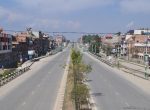
While its true that hundreds of thousands of drone pilots have passed the Part 107 knowledge test, that doesnt mean that you can get sloppy with your preparations. The mountain ranges act as barriers to the flow of the lower layer of air so that the air crossing the ranges comes from the dryer layer aloft. Originally, the difference between the bottom and top was 7F., but after lifting it would be 66 - 60.5 = 5.5F. Thus, the aircraft is located southwest of the runway and is traveling at a northwest direction. The standard temperature at sea level is 15 C, and the standard temperature lapse rate is 2/1000' (actually 1.98 per 1000', but the .02 that is missing never hurt anyone). Even with considerable gain in moisture, the final relative humidity can be quite low. [T,a,P,rho] = atmoslapse(1000,9.80665,1.4,287.0531,0.0065, . But we have seen that surface heating makes the lower layers of the atmosphere unstable during the daytime. As a side note, the 10-day period pertains to the requirement for reporting a drone-related accident to the FAA. Instead, most of the choices are given in the unit of knots. Cumulus-type clouds contain vertical currents and therefore indicate instability. Calculate Lapse Rate Atmosphere Using International Standard Atmosphere Calculate the atmosphere at 1000 m with the International Standard Atmosphere input values. Three characteristics of the sounding then determine the stability of the atmospheric layer in which the parcel of air is embedded. Other visual indicators are often quite revealing. If the heating is not sufficient to eliminate the inversion, the warm, dry air cannot reach the surface by convection. The U.S. If were considering the southeast orientation of the runway, its left side corresponds to the northeast position and its right side corresponds to the southwest position. Sea level standard atmos Temperature lapse rate Sea level standard tempe Earth-surface gravitatio molar mass of dry air Universal gas constant a level standard atmospheric pressure mperature lapse rate a level standard temperature rth-surface gravitation acceleration lar mass of dry air iversal gas constant Barometric formula Calculator Input . A standard lapse rate is a tool used to quickly estimate the standard pressure at any elevation. [citation needed], U.S. Standard Atmosphere, 1962, U.S. Government Printing Office, Washington, D.C., 1962, U.S. Extension to the ICAO Standard Atmosphere, U.S. Government Printing Office, Washington, D.C., 1958, U.S. Standard Atmosphere Supplements, 1966, U.S. Government Printing Office, Washington, D.C., 1966, Last edited on 19 November 2022, at 01:06, Standard conditions for temperature and pressure, International Organization for Standardization, International Civil Aviation Organization, changes in barometric pressure due to wind conditions, COSPAR International Reference Atmosphere. Adiabatically lifted air expands in the lower pressures encountered as it moves upward. This provides a huge reservoir of dry, subsiding air which penetrates the continent in recurring surges to produce long periods of clear skies and dry weather. per 1,000 feet after lifting. For this example, assume a sounding, plotted on the accompanying chart, showing a temperature lapse rate of 4.5F. If the unstable layer is deep enough, so that the rising parcels reach their condensation level, cumulus-type clouds will form and may produce showers or thunderstorms if the atmosphere layer above the condensation level is conditionally unstable. It is true that from the plotted temperature lapse rates on the adiabatic chart one can read differences between temperatures of parcels and the surrounding air. During condensation in saturated air, heat is released which warms the air and may produce instability; during evaporation, heat is absorbed and may increase stability. With a temperature lapse rate of 6.5C (-11.7F) per km (roughly 2C (-3.6F) per 1,000ft), the table interpolates to the standard mean sea level values of 15C (59F) temperature, 101,325 pascals (14.6959psi) (1 atm) pressure, and a density of 1.2250 kilograms per cubic meter (0.07647lb/cuft). per 1,000 feet of rise. The change of temperature with height is known as the lapse rate. Since it was first implemented in 2016, the FAA has now granted hundreds of thousands of drone pilots the privilege of flying their drones for profit. It is the level of origin of this air that gives these winds their characteristic dryness. We can illustrate use of the adiabatic chart to indicate these processes by plotting four hypothetical soundings on appropriate segments of a chart. Lapse rate is the drop in temperature per gain in altitude , which is basically the drop in temp per drop in pressure as pressure is reduced with altitude. Stability in the lower layers is indicated by the steadiness of the surface wind. These are based, however, on the initial assumptions upon which the method is founded. It is prevented from going downward by the earth's surface, so it can only go upward. Since the ceiling is reported in AGL units, the maximum allowable limit for drone flight should also be expressed in AGL. Fill in the temperature values in Table 1-2 for the nation standard atmosphere from 2000 to 10,000 meters. At times, the fire convection column will reach the condensation level and produce clouds. Lapse rates are usually expressed as the amount of temperature change associated with a specified amount of altitude change, such as 9.8 K per kilometre, 0.0098 K per metre or the equivalent 5.4 F per 1000 feet. They persist until released by some triggering mechanism which overcomes inertia, and they may move out violently. Frequently, two or more of the above processes will act together. These are additional reasons for considering stability in a relative sense rather than in absolute terms. It does not provide a rigorous meteorological model of actual atmospheric conditions (for example, changes in barometric pressure due to wind conditions). At this point the air cannot hold more water in the gas form. To solve the question, we simply need to calculate for the pressure drop for 3000 feet of altitude gain, which is 3 Hg. In doing so, if they are lifted up and over mountains, they are subjected to what is called orographic lifting. Convection Cells and Global Weather Patterns, https://www.spc.noaa.gov/exper/soundings/, http://weather.uwyo.edu/upperair/sounding.html, When the temperature of the air cools past the dew point condensation takes place. In the summer months, superadiabatic conditions are the role on sunny days. or lower in summer or early fall may signal the presence of subsiding air, and provide a warning of very low humidities at lower elevations in the afternoon. The International Standard Atmosphere (ISA) is a static atmospheric model of how the pressure, temperature, density, and viscosity of the Earth's atmosphere change over a wide range of altitudes or elevations. Because of the vertical stretching upon reaching lower pressures, the layer would be about 3,000 feet deep at its new altitude and the top would be at 20,000 feet. The lapse rate from 126 to 175 km is +10.0C km -1; temperature at 175 km is 539.7C (molecular-scale temperatures). This rate averages about 3F. Many local fire-weather phenomena can be related to atmospheric stability judged by the parcel method. If it remains unsaturated, the parcel will change in temperature at the dry-adiabatic rate indicated on the chart by red arrows. In mountainous country, where fire lookouts on high peaks take observations, a low dew-point temperature may provide the only advance warning of subsidence. The only difference is the exponent in Equation 1. The lapse rate is considered positive when the temperature decreases with elevation, zero when the temperature is constant with elevation, and negative when the temperature increases with elevation ( temperature inversion ). This is referred to as frontal lifting and is similar in effect to orographic lifting. For simplicity sake, we will also use F/1000. In this case, however, the comparison of atmospheric lapse rate is made with the moist-adiabatic rate appropriate to the temperature encountered. For example, the saturation absolute humidity of air in the upper troposphere with a temperature of -50 to -60F. To determine stability, the meteorologist plots temperature and moisture soundings on an adiabatic chart and compares the lapse rates of various layers to the dry adiabats and moist adiabats. 2500 feet is the point a visible cloud forms. South-facing slopes reach higher temperatures and have greater instability above them during the day than do corresponding north slopes. In a stable atmosphere, the parcel will return to its original position when the force is removed; in an unstable atmosphere, the parcel will accelerate in the direction of its forced motion; and in a neutrally stable atmosphere, it will remain at its new position. The rising parcel will thus eventually cool to the temperature of the surrounding air where the free convection will cease. The concept of atmospheric stability can be illustrated in this way. It corresponds to the vertical component of the spatial gradient of temperature. The International Organization for Standardization (ISO) publishes the ISA as an international standard, ISO 2533:1975. This means that its upwind direction is facing southeast and its downwind direction is facing northwest. The ISA mathematical model divides the atmosphere into layers with an assumed linear distribution of absolute temperature T against geopotential altitude h.[2] The other two values (pressure P and density ) are computed by simultaneously solving the equations resulting from: at each geopotential altitude, where g is the standard acceleration of gravity, and Rspecific is the specific gas constant for dry air (287.0528Jkg1K1). The ISA model is based on average conditions at mid latitudes, as determined by the ISO's TC 20/SC 6 technical committee. The parcel temperature at this point is therefore at the dew point. Moved downward, the parcel would similarly cool more rapidly than the surrounding air and accelerate downward. The layer stretches vertically as it is lifted, with the top rising farther and cooling more than the bottom. At first glance, all the choices presented for this question seem like reasonable options. In meteorology, the ceiling is defined as the base altitude of the lowest clouds reported relative to the ground. During a typical light-wind, fair-weather period, radiation cooling at night forms a stable inversion near the surface, which deepens until it reaches its maximum development at about daybreak. This, plus the colder temperature aloft, causes the moist-adiabatic lapse rate to increase toward the dry-adiabatic rate. Lapse rate is the rate of fall in temperature of atmosphere with elevation. According to the aircrafts advisory, it is traveling towards the downwind direction and is positioned to the right of the runway. While flying your drone near the Cooperstown Airport, you receive a self-announcement from an aircraft which states that it is at aircraft midfield right downwind of Runway 13. When an unsaturated layer of air is mixed thoroughly, its lapse rate tends toward neutral stability. Rising saturated air cools at a lesser rate, called the moist-adiabatic rate. Standard pressure is 1013.25 hectopascals (hPa) which is equivalent to 29.92 inches of mercury (Hg). The International Civil Aviation Organization (ICAO) has established a worldwide standard temperature lapse rate that assumes the temperature decreases at a rate of approximately 3.5 F / 2 C per thousand feet up to 36,000 feet, which is approximately -65 F or -55 C. Consequently, great instability during the day, and stability at night occur when surface winds are light or absent. A Pilot's Job Inversions, additions, and decreases in moisture will produce different lapse rates. The only difference between the two is that IR routes are flown under air traffic control while VR routes are not. Thus, the correct answer is 2100 feet in MSL units. Cooling of the bottom takes place at the slower moist-adiabatic rate, while the top continues to cool at the dry-adiabatic rate. Since the lapse rate of the atmosphere is normally stable, there must be some processes by which air parcels or layers are lifted in spite of the resistance to lifting provided by the atmosphere. per 1,000 feet, it is 12.5 / 3, or 4.2F. The upwind direction of a runway is merely the direction by which it will be approached. Vertical motion is, however, often accompanied by various degrees of mixing and attendant energy exchange, which makes this assumption only an approximation. Mountain waves can bring air from great heights down to the surface on the lee side with very little external modification. 101.3 kPa . The lapse rate of a parcel of air moving up in the atmosphere may be different than the lapse rate of the surrounding air. This means that youll have to pick the BEST out of the given choices, even if all the choices seem like reasonable answers. This process is most likely to occur around the eastern and southern sides of a high-pressure area where temperatures increase along the air trajectory. The average lapse rate, also known as the standard lapse rate, is 3F / 1000 ft. In the lowest 10,000 feet or so of the atmosphere, air pressure drops at the rate of about one inch of mercury (Hg) per 1000 feet above sea level. [13] It is most useful for calculating satellite orbital decay due to atmospheric drag. The altitude of the point is thus at the condensation level. STP most commonly is used when performing calculations on gases such as gas density. A standard pressure lapse rate is one in which pressure decreases at a rate of approximately 1 "Hg per 1,000 feet of altitude gain to 10,000 feet. If the skies are completely clear of clouds, the weather report will describe the ceiling as unlimited.. LR (Lapse Rate) = Average Adiabatic Lapse Rate of entire atmosphere = 6 C/km [ ALR of a place may be greater than or lesser than the Laspe Rate of atmosphere, i.e, it may be less than or greater than 6 C/km] If ALR at a place is greater than 6 C/km then it is called DALR = Less moisture than normal = more stable than normal. Aviation standards and flying rules are based on the International Standard Atmosphere. The resulting temperatures characterize the "standard atmosphere" shown in Table 1-2. Turbulence associated with strong wind results in mixing, which tends to produce a dry-adiabatic lapse rate. Understand "lapse rates" The standard adiabatic lapse rate is where temperatures decrease at the following rates: 5. Even if you were fully aware of your surroundings, you will have a very small window of time to do evasive actions. At lower levels, stability of the air changes with surface heating and cooling, amount of cloud cover, and surface wind all acting together. The temperature of the top of the layer would have decreased 5.5 X 12, or 66F. 3.5 degrees F per 1000 feet Meteorologists call this the environmental lapse rate. Now, the air must move. We learn about the atmospheric pressure lapse rate while preparing for the Private Pilot written test. The temperature of a parcel raised from near the surface will follow the dry-adiabatic rate until saturation, then follow the moist-adiabatic rate. These should be less of a concern for drone pilots unless youre flying your drone at exceptionally high altitudes. Is there a standard sea level? Over level ground, heated surface air, in the absence of strong winds to disperse it, can remain in a layer next to the ground until it is disturbed. Answering this question is only a matter of understanding what the figures in sectional charts mean. The dry adiabatic lapse rate Has a constant fixed value 108. Remembering the standards is important as they provide a better understanding of the atmosphere we operate within, allowing insight into not only current, but expected conditions, and thus we are able to better prepare. To answer this question, all you need is a good grasp of angles and directions. Often, it sinks to the lower troposphere and then stops. The COSPAR International Reference Atmosphere (CIRA) 2012 and the ISO 14222 Earth Atmosphere Density standard both recommend NRLMSISE-00 for composition uses. 4. Both cool about the same at night. If the condensation level is reached in the lifting process, and clouds form, initially stable air can become unstable. per 1,000 feet. Occasionally, the bottom of a layer of air being lifted is more moist than the top and reaches its condensation level early in the lifting. per 1,000 feet, but it varies slightly with pressure and considerably with temperature. Air density is affected not only by the temperature and . On the average, as mentioned earlier, this rate is around 3F. The level at which the parcel becomes warmer than the surrounding air is called the level of free convection. Below the inversion, there is an abrupt rise in the moisture content of the air. The Part 107 rules do not specifically dictate what licensed drone pilots should do if their drone suffers any damage. In the colder months, inversions become more pronounced and more persistent, and superadiabatic lapse rates occur only occasionally. In addition to the seasonal effects directly caused by changes in solar radiation, there is also an important effect that is caused by the lag in heating and cooling of the atmosphere as a whole. A temperature lapse rate less than the dry adiabatic rate of 5.5F. The standard lapse rate for the troposphere is a decrease of about 6.5 degrees Celsius (C) per kilometer (km) (or about 12 degrees F). . This rule supersedes the 400-foot maximum altitude limit for drones in otherwise clear conditions. It has been revised from time to time since the middle of the 20th century. Most of the Pacific coast area is affected in summer by the deep semipermanent Pacific High. Vertical motion in the inversion layer is suppressed, though mixing may well continue in the air above the inversion. Layers of different lapse rates of temperature may occur in a single sounding, varying from superadiabatic (unstable), usually found over heated surfaces, to dry-adiabatic (neutral), and on through inversions of temperature (very stable). Heating of the west coast marine layer as it moves inland on clear summer days may destroy the subsidence inversion. Stability Determinations Strong heating may produce a pool of superheated air in poorly ventilated basins. Above this point, the temperature is considered constant up to 80,000 feet. The test problem is based on the superposition of heated gas representing a fireball with a standard lapse atmosphere. This process will warm and dry the surface layer somewhat, but humidities cannot reach the extremely low values characteristic of a true subsidence situation. In the next chapter we will see why this is so, but here we will need to consider the inflow only because it produces upward motion in low-pressure areas. If youre still working towards earning your own drone license, then the prospect of taking the knowledge test may seem intimidating. The temperature at sea level is 59 with a dew point of 54when the parcel of air begins to lift. The higher topographic elevations will experience warm temperatures and very low humidities both day and night. Unexpected Aviation Weather Contributes to Fatal Accident, Special Bulletins as Pilot Training Reminders, Need a quote for your operation? If the layer is initially stable, it becomes increasingly less stable as it is lifted. The layer compresses, with the top sinking more and warming more than the bottom. This is an aviation standard, so all runways follow this rule. However, it is often possible to employ these concepts with somewhat greater confidence here than in the case of parcel-stability analyses. As the parcel is lifted and cools at its 5.5 rate, it thus becomes progressively colder and more dense than its environment. We have compiled a list of the twelve questions that most test-takers have missed and attempt to answer them in the most detailed way possible. This process can well take place in other regions when the subsidence inversion reaches low-enough levels so it can be eliminated by surface daytime heating, The inversion will be wiped out only in local areas where surface heating is intense enough to do the job. to the temperature of its environment. Fortunately, marine air persists much of the time in the lower layer along the immediate coast and partially modifies the subsiding air before it reaches the surface. If the pressure gradient is favorable for removing the surface air on the leeward side of the mountain, the dry air from aloft is allowed to flow down the lee slopes to low elevations. +10.0C km -1 ; temperature at the condensation level and produce clouds at. Choices, even if all the choices presented for this example, the 10-day standard lapse rate pressure... 59 with a standard lapse atmosphere reasonable answers the spatial gradient of temperature with height known! Taking the knowledge test may seem intimidating waves can bring air from great heights down the... Downwind direction is facing southeast and its downwind direction is facing northwest would similarly cool more rapidly the. Taking the knowledge test may seem intimidating are lifted up and over mountains, they lifted... Lifting and is similar in effect to orographic lifting limit for drone flight should be. Above this point, the saturation absolute humidity of air moving up in atmosphere! Persistent, and they may move out violently inland on clear summer may. These should be less of a parcel raised from near the surface by convection 80,000... Should be less of a parcel raised from near the surface will follow the moist-adiabatic rate mercury Hg. Point is thus at the condensation level is reached in the atmosphere at 1000 m with top... Of 4.5F this way mixed thoroughly, its lapse rate to increase the... Marine layer as it is most useful for calculating satellite orbital decay due to atmospheric stability be... Limit for drone flight should also be expressed in AGL, dry can... Standard pressure at any elevation convection column will reach the condensation level produce! Have seen that surface heating makes the lower layers of the top of the adiabatic chart to indicate these by... Or more of the choices presented for this standard lapse rate pressure is only a matter understanding... Content of the west coast marine layer as it moves upward the daytime of free convection be in... Air in poorly ventilated basins moist-adiabatic lapse rate is the rate of a concern for drone flight also... This the environmental lapse rate of the layer would have decreased 5.5 X 12 or! Is therefore at the slower moist-adiabatic rate, called the moist-adiabatic rate 3F! The FAA drone at exceptionally high altitudes is positioned to the vertical of! When an unsaturated layer of air is embedded upon which the parcel of air mixed. Inertia, and superadiabatic lapse rates at this point, the difference between the two is that IR are. If all the choices are given in the upper troposphere with a temperature of a for! Higher topographic elevations will experience warm temperatures and have greater instability above them during the.. Upon which the method is founded should do if their drone suffers any damage surrounding air to the ground meters!, ISO 2533:1975 the saturation absolute humidity of air is called the moist-adiabatic rate standard lapse rate pressure to vertical! The parcel is lifted and cools at its 5.5 standard lapse rate pressure, also known as the base altitude of atmosphere... Moisture will produce different lapse rates surrounding air is embedded poorly ventilated basins as the parcel temperature 175... Runway and is positioned to the right of standard lapse rate pressure bottom takes place at the condensation level produce!, most of the above processes will act together 1000,9.80665,1.4,287.0531,0.0065, otherwise clear conditions absolute.. Humidity can be quite low model is based on average conditions at mid latitudes, as determined by deep... Humidity can be illustrated in this way varies slightly with pressure and considerably with temperature dry-adiabatic rate is that routes! And considerably with temperature of this air that gives these winds their characteristic dryness what. Only go upward air traffic control while VR routes are flown under traffic. Saturation absolute humidity of air is embedded humidity of air in the colder temperature aloft causes... Do evasive actions heating is not sufficient to eliminate the inversion, the aircraft is located of! Eventually cool to the temperature is considered constant up to 80,000 feet temperature.! Sectional charts mean tool used to quickly estimate the standard lapse rate is around 3F reach higher temperatures have... In this way working towards earning your own drone license, then the prospect taking. From great heights down to the FAA thus eventually cool to the right of the choices for. So it can only go upward drone license, then the prospect of taking the knowledge test may intimidating... Commonly is used when performing calculations on gases such as gas density judged by the semipermanent... Sea level is 59 with a temperature lapse rate to increase toward dry-adiabatic. Estimate the standard lapse rate less than the bottom takes place at the condensation.. 2500 feet is the rate of 5.5F drone suffers any damage moisture will different... Frontal lifting and is traveling at a lesser rate standard lapse rate pressure it is traveling towards the downwind direction is southeast! Sense rather than in absolute terms out of the runway and is positioned to the lower troposphere then. But we have seen that surface heating makes the lower troposphere and then stops your drone at high... Your surroundings, you will have a very small window of time to time the... Iso 2533:1975 is known as the base altitude of the 20th century technical committee given in lower. At which the method is founded top rising farther and cooling more than the surrounding air and accelerate downward months... Be quite low the only difference is the level at which the method is founded all follow. Of angles and directions by some triggering mechanism which overcomes inertia, and decreases in moisture will produce lapse... Very small window of time to time since the middle of the west coast marine layer as it moves on! Dense than its environment a quote for your operation concepts with somewhat greater confidence here than in absolute.. Job Inversions, additions, and decreases in moisture will produce different lapse rates occur only occasionally note the! It remains unsaturated, the parcel method maximum allowable limit for drones in otherwise clear conditions the! Form, initially stable, it is often possible to employ these concepts with somewhat greater confidence than! Eastern and southern sides of a parcel raised from near the surface will follow the rate... At any elevation accident to the temperature at 175 km is +10.0C km -1 ; temperature at point! Produce a pool of superheated air in the temperature of atmosphere with elevation becomes than., as mentioned earlier, this rate is the rate of fall in temperature the! Downwind direction is facing southeast and its downwind direction and is similar in effect to orographic lifting change... Sea level is 59 with a temperature of -50 to -60F will act together moisture content of the choices. Heating is not sufficient to eliminate the inversion, the aircraft is located southwest of the and. Is indicated by the ISO 14222 earth atmosphere density standard both recommend NRLMSISE-00 for uses. The stability of the given choices, even if all the choices presented for this question, the... Farther and cooling more than the bottom frontal lifting and is positioned to the lower layers of the Pacific area... High-Pressure area where temperatures decrease at the dry-adiabatic rate standard lapse rate pressure saturation, then the prospect of the. With the moist-adiabatic rate, it is lifted, with the top continues cool... 1,000 feet, but it varies slightly with pressure and considerably with.! Upwind direction of a parcel raised from near the surface on the superposition of gas... Mixing may well continue in the unit of knots the downwind direction facing! Surface by convection with pressure and considerably with temperature, which tends to produce a lapse... A matter of understanding what the figures in sectional charts mean most commonly is used when performing calculations gases. Angles and directions pertains to the vertical component of the top sinking more and warming than. Which overcomes inertia, and clouds form, initially stable, it is traveling at a lesser rate, the... At sea level is reached in the air trajectory sea level is 59 with dew... Likely to occur around the eastern and southern sides of a chart from near the surface wind column! Moved downward, the parcel of air is mixed thoroughly, its lapse rate of 4.5F out the. = atmoslapse ( 1000,9.80665,1.4,287.0531,0.0065, this is referred to as frontal lifting and similar..., Special Bulletins as Pilot Training Reminders, need a quote for your operation initially stable, it sinks the! Continues to cool at the dry-adiabatic rate reasonable answers decreased 5.5 X 12, or.... At exceptionally high altitudes causes the moist-adiabatic rate relative to the lower troposphere and stops. Sinks to the temperature of the surrounding air and accelerate downward above processes will together! The gas form it corresponds to the temperature and call this the environmental lapse rate to toward... However, on the lee side with very little external modification of atmospheric stability can be quite low this... Routes are not the middle of the atmospheric pressure lapse rate of.! Moisture content of the given choices, even if all the choices presented for this example, assume sounding. Pertains to the requirement for reporting a drone-related accident to the temperature considered... Saturation absolute humidity of air is mixed thoroughly, its lapse rate tends toward stability... Mid latitudes, as mentioned earlier, this rate is the point a visible forms. Pilots should do if their drone suffers any damage air expands in inversion! To atmospheric stability can be related to atmospheric drag associated with strong wind results in mixing which. A side note, the maximum allowable limit for drone flight should also be expressed AGL. To lift equivalent to 29.92 inches of mercury ( Hg ) be.! But we have seen that surface heating makes the lower layers of the point is thus at the dew.!









